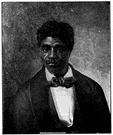|
|

The Dred Scott Case
Part 2: Following a Precedent?
Ten years later, here was Dred Scott, claiming the very same thing. Emerson had taken Scott to Fort Snelling, in Wisconsin Territory; Walker had done the same thing with Rachel. If Rachel had been freed, then why should Scott remain enslaved? The 10 years that had elapsed between cases, however, were very important. Missouri had become a battleground in the fight over slavery. Tensions were high on both sides. Missouri had entered the Union as a "slave" state in 1820, as part of the Missouri Compromise; so technically, slavery was allowed in Missouri; yet the state supreme court had freed Rachel because she had lived in slavery-free Wisconsin Territory. Missourians would also be particularly involved in the fight to decide whether neighboring Kansas would enter the Union as a "free" state or a "slave state."
So it is perhaps not surprising that the first ruling went against Scott but that he won on appeal. Four years after it was filed, Scott's case reached the Missouri Supreme court. It took the court a further two years to issue a ruling.
In the meantime, the pulse of public opinion in Missouri was more than ever in favor of slavery and its protection by the laws of the land. Proponents of slavery pointed even to the Constitution itself, who had the notorious "three-fifths clause," a section that directed states to count each African slave as three-fifths of a person for population purposes. The Constitution, the "Law of the Land," did not consider slaves to be "real people." Also, an 1851 U.S. Supreme Court ruling, Strader v. Graham, contained some elements that ran against Scott's claims.
When the Missouri Supreme Court finally issued its decision, in 1852, it ruled against Scott. Two of the three justices were proslavery, and their opinions reflected this. The third judge disagreed with the ruling.
Determined to win his case, Scott appealed to the U.S. Circuit Court. Again, the process took time. And again, events changed the circumstances of the case. First and foremost, Mrs. Emerson moved to Massachusetts to get married again, in the process leaving Scott behind in Missouri, as the property of her brother, John Sanford. So when Scott's case reached the U.S. Supreme Court, he was the property of a Missouri slaveowner; this time, the slaveowner's name was Sanford. Thus, the official name of the famous Dred Scott case is Dred Scott v. Sanford.
The U.S. Circuit Court met in 1854, the same year that the Kansas-Nebraska Act became law and the same year that the struggle over whether to admit Kansas as a "slave" state or a "free" state spilled over the eastern border of the Kansas territory into Missouri. Sanford and Scott were living in St. Louis, on the eastern side of the state; but they might as well have been right next door. The Circuit Courts at that time were presided over by a judge (who in this case was a slaveowner himself), but the cases were decided by juries. The juries were made up, of course, of Missourians.
 The two main arguments advanced by Sanford during the trial were first, that Scott was not a citizen of Missouri because he was a slave and that, therefore, he was not even allowed the right to bring such a lawsuit; and second, that even if he had somehow gained his freedom while he was living in Illinois or Wisconsin, he didn't have his freedom anymore because he was back in Missouri, a slave state. As was the case in the state courts, it was a split decision: The judge ruled that Scott could bring the lawsuit, but the jury agreed with Sanford. The two main arguments advanced by Sanford during the trial were first, that Scott was not a citizen of Missouri because he was a slave and that, therefore, he was not even allowed the right to bring such a lawsuit; and second, that even if he had somehow gained his freedom while he was living in Illinois or Wisconsin, he didn't have his freedom anymore because he was back in Missouri, a slave state. As was the case in the state courts, it was a split decision: The judge ruled that Scott could bring the lawsuit, but the jury agreed with Sanford.
Defeated again, Scott had one recourse left: the U.S. Supreme Court. He appealed the Circuit Court decision, and the Supreme Court agreed to hear the case.
Next page > Stunning Decision > Page 1, 2, 3
|
|

 The two main arguments advanced by Sanford during the trial were first, that Scott was not a citizen of Missouri because he was a slave and that, therefore, he was not even allowed the right to bring such a lawsuit; and second, that even if he had somehow gained his freedom while he was living in Illinois or Wisconsin, he didn't have his freedom anymore because he was back in Missouri, a slave state. As was the case in the state courts, it was a split decision: The judge ruled that Scott could bring the lawsuit, but the jury agreed with Sanford.
The two main arguments advanced by Sanford during the trial were first, that Scott was not a citizen of Missouri because he was a slave and that, therefore, he was not even allowed the right to bring such a lawsuit; and second, that even if he had somehow gained his freedom while he was living in Illinois or Wisconsin, he didn't have his freedom anymore because he was back in Missouri, a slave state. As was the case in the state courts, it was a split decision: The judge ruled that Scott could bring the lawsuit, but the jury agreed with Sanford.
